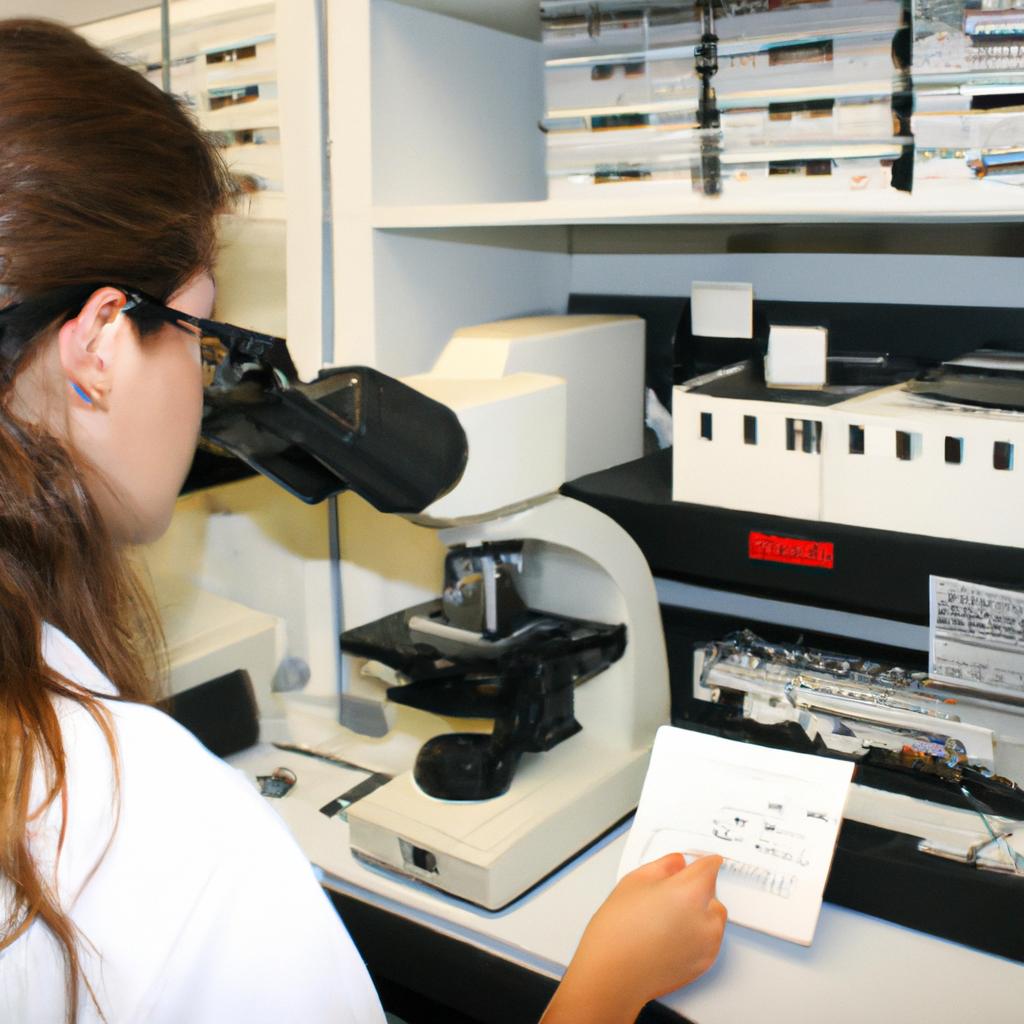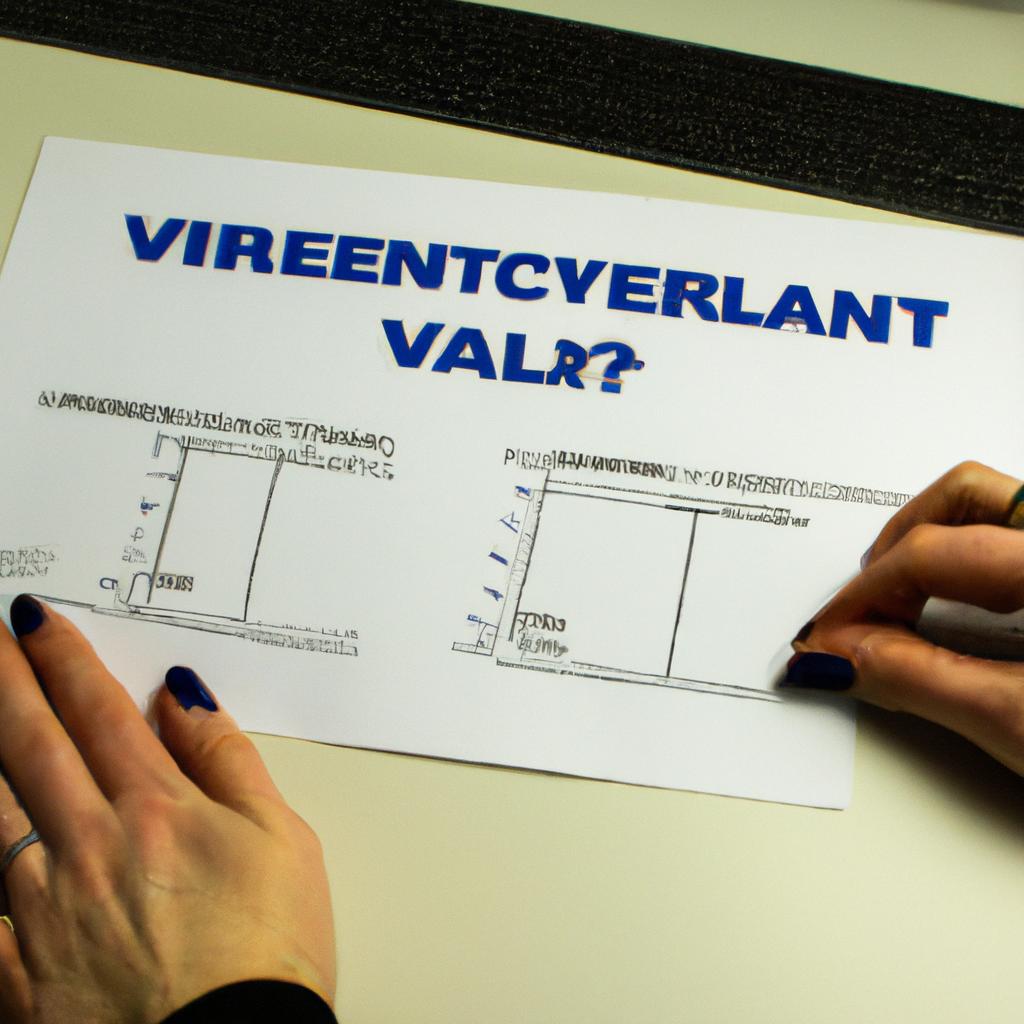Veterinary care plays a crucial role in promoting the health and well-being of animals. However, accessing specialized veterinary services can be financially burdensome for many pet owners. This is especially true when it comes to veterinary clinical pathology, which involves diagnostic testing and analysis to aid in the diagnosis, treatment, and monitoring of various diseases. In such situations, charitable organizations offering financial assistance play a vital role in ensuring that pets receive the necessary laboratory services they require.
For instance, consider a hypothetical scenario where a family with limited financial resources owns a beloved dog that shows signs of persistent lethargy and weight loss. Concerned about their pet’s well-being but unable to afford expensive tests at private clinics, they turn to charitable organizations specializing in veterinary clinical pathology. These organizations not only provide financial aid but also facilitate access to advanced laboratory facilities equipped with state-of-the-art technology. By doing so, these charities enable veterinarians to perform comprehensive blood workups and other essential diagnostic procedures, ultimately leading to accurate diagnoses and tailored treatment plans.
In this article, we will explore the importance of charitable organizations in facilitating affordable access to veterinary clinical pathology services. We will examine how these organizations operate, highlight some notable examples of successful initiatives worldwide, discuss potential challenges they face, and shed light on the impact they have on both pets and their owners.
Charitable organizations that focus on veterinary clinical pathology services work diligently to bridge the gap between financial limitations and the need for diagnostic testing. These organizations rely on donations from individuals, corporations, and grants to fund their operations. By leveraging these resources, they can subsidize or completely cover the costs of laboratory tests for eligible pet owners.
One notable example of a successful charitable organization in this field is The Pet Fund, based in California, USA. They offer financial assistance to pet owners who cannot afford veterinary care, including clinical pathology services. The Pet Fund collaborates with veterinarians and laboratories to provide necessary diagnostic testing at reduced rates or no cost at all. Through their efforts, numerous pets have received accurate diagnoses and appropriate treatments that may not have been possible otherwise.
Another global initiative worth mentioning is International Veterinary Outreach (IVO). This organization focuses on providing veterinary care to underserved communities around the world. Their programs often include access to clinical pathology services as part of comprehensive healthcare interventions for animals in need. By partnering with local clinics and laboratories, IVO ensures that these essential diagnostic tools are available even in remote areas where resources are limited.
Despite the significant positive impact charitable organizations have on promoting affordable access to veterinary clinical pathology services, there are challenges they face. One major obstacle is the limited availability of funds and resources needed to meet the growing demand for assistance. As more pet owners seek help from these organizations due to financial constraints, it becomes increasingly difficult for them to keep up with the rising costs of veterinary care.
Moreover, some regions may lack an adequate number of participating clinics or laboratories willing to collaborate with charitable organizations. This can create geographical barriers for pet owners seeking assistance in certain areas.
In conclusion, charitable organizations specializing in veterinary clinical pathology play a vital role in ensuring that pets receive essential diagnostic testing despite financial constraints faced by their owners. These organizations provide funding and facilitate access to advanced laboratory facilities, enabling accurate diagnoses and tailored treatment plans. While they face challenges such as limited resources and geographical barriers, their impact on promoting the health and well-being of animals cannot be understated. With continued support from donors and collaboration with veterinary professionals, these organizations can continue to make a difference in the lives of pets and their owners.
Importance of Charitable Organizations in Veterinary Care
Importance of Charitable Organizations in Veterinary Care
Charitable organizations play a crucial role in providing financial assistance for veterinary care, ensuring that animals receive the necessary medical attention regardless of their owners’ financial circumstances. One such organization is the Animal Health Foundation (AHF), which has been instrumental in helping animals in need. For instance, consider the case of Max, a lovable Labrador Retriever who was diagnosed with a life-threatening condition requiring immediate treatment. Unfortunately, Max’s owner could not afford the high costs associated with his veterinary care. However, thanks to AHF’s financial support, Max received the essential treatment and made a full recovery.
The impact of charitable organizations on animal health cannot be overstated. They provide much-needed resources and support to ensure that every pet receives appropriate medical attention and necessary treatments. To illustrate this further, let us explore four key ways in which these organizations contribute to improving animal welfare:
- Financial Assistance: Charitable organizations often offer grants or subsidies to cover the cost of veterinary services for individuals who are unable to afford them. This allows pets from low-income households to access vital healthcare without compromising their well-being.
- Education and Outreach Programs: Many charities focus not only on offering direct financial aid but also on educating pet owners about preventative measures and responsible pet ownership. By promoting awareness and knowledge within communities, they help prevent diseases and reduce future healthcare expenses.
- Rehabilitation Centers: Some charitable organizations establish rehabilitation centers where injured or neglected animals can receive specialized care until they are ready for adoption. These facilities provide comprehensive medical treatments along with emotional support, aiming to improve the overall quality of life for these vulnerable creatures.
- Research Funding: Charities also allocate funds towards research initiatives aimed at advancing veterinary medicine and discovering new treatments for various ailments affecting animals. Such scientific endeavors have far-reaching implications by contributing to ongoing advancements in clinical practices and ultimately benefiting countless pets worldwide.
In recognizing the pivotal role played by charitable organizations in veterinary care, it becomes evident that their efforts extend beyond financial assistance alone. By providing education, rehabilitation services, and funding for research endeavors, these organizations contribute significantly to the overall well-being of animals.
Transitioning into the subsequent section about “Understanding the Role of Veterinary Clinical Pathology in Animal Health,” it is crucial to delve deeper into the field of veterinary medicine to comprehend how various aspects come together to ensure comprehensive healthcare for our furry companions.
Understanding the Role of Veterinary Clinical Pathology in Animal Health
Having discussed the significance of charitable organizations in veterinary care, it is essential to understand how veterinary clinical pathology plays a crucial role in ensuring animal health and well-being. To illustrate this further, let us consider a hypothetical case study involving an injured stray dog.
Case Study: A stray dog with an unknown history was brought to a local animal shelter after being hit by a car. The shelter’s primary concern was to assess the extent of the dog’s injuries and provide appropriate medical treatment. This is where veterinary clinical pathology comes into play.
Paragraph 1:
Veterinary clinical pathology involves laboratory testing and analysis that aids veterinarians in diagnosing diseases, monitoring treatment progress, and assessing overall health conditions in animals. In our case study, the veterinarian ordered several tests through which valuable information about the dog’s condition could be obtained. These tests included blood work for complete blood count (CBC), serum biochemistry analysis, urinalysis, and cytological examination of fluid samples collected from potential internal injuries.
Some key contributions of veterinary clinical pathology include:
- Early detection of diseases or abnormalities
- Evaluation of organ function and overall health status
- Monitoring response to treatment
- Identification of underlying causes for symptoms
Paragraph 2:
To better comprehend the impact of these diagnostic procedures, let us consider a sample table displaying test results for our injured stray dog:
| Test | Result | Reference Range |
|---|---|---|
| CBC | Normal | N/A |
| Serum Biochemistry | Elevated liver enzymes | Within normal limits |
| Urinalysis | Blood present | Negative |
| Cytology | Suspicious cells | N/A |
This tabulated data provides vital insights into the dog’s condition. The elevated liver enzymes indicate potential organ damage caused by the accident, while blood present in the urine suggests possible internal bleeding. The suspicious cells found through cytology prompt further investigation for cancer or other abnormalities.
Paragraph 3:
By employing veterinary clinical pathology techniques and interpreting the results, veterinarians can make informed decisions regarding appropriate treatment plans for animals like our stray dog. These findings enable them to address underlying health issues promptly and effectively, ultimately improving the animal’s chances of recovery and ensuring their overall well-being.
Transition into subsequent section about “Challenges Faced by Pet Owners in Accessing Veterinary Care”:
Understanding the pivotal role played by veterinary clinical pathology in animal healthcare highlights the significance of accessible veterinary care for all pet owners. However, numerous challenges hinder many individuals from obtaining necessary medical assistance for their beloved companions. Let us explore these hurdles that pet owners face when seeking veterinary care.
Challenges Faced by Pet Owners in Accessing Veterinary Care
Veterinary clinical pathology plays a crucial role in diagnosing and treating diseases in animals. By analyzing blood, urine, and tissue samples, veterinary pathologists can provide valuable insights into an animal’s overall health status and assist veterinarians in making accurate diagnoses. To illustrate the significance of this field, let us consider a hypothetical case study:
Imagine a middle-aged dog named Max who is exhibiting signs of lethargy, decreased appetite, and weight loss. Concerned about his beloved pet’s condition, the owner brings Max to a veterinary clinic for further evaluation. The veterinarian suspects an underlying systemic disease but needs more information to establish a definitive diagnosis.
In such cases, veterinary clinical pathology becomes indispensable. Through comprehensive laboratory tests on Max’s blood samples, including complete blood count (CBC), serum chemistry panel, and coagulation profile, veterinary pathologists can identify abnormalities that may indicate specific diseases or dysfunctions within various organ systems. In Max’s case, abnormal CBC results reveal low red blood cell count and increased white blood cells—an indication of possible immune-mediated or infectious disorders requiring immediate attention.
The importance of timely access to veterinary care cannot be overstated; however, many pet owners face challenges when it comes to affording necessary medical services for their beloved companions. Consider the following points:
- High-cost treatments: Advanced diagnostic procedures like specialized imaging techniques or molecular testing can incur significant expenses that may not be feasible for all pet owners.
- Limited financial resources: Some individuals may struggle financially due to personal circumstances or unexpected emergencies, making it difficult for them to allocate funds towards their pets’ healthcare needs.
- Lack of insurance coverage: Unlike human healthcare systems where insurance plans are common practice, pet insurance remains relatively uncommon. This lack of coverage leaves some owners responsible for bearing the full cost burden themselves.
- Geographic limitations: In rural or underserved areas, veterinary services may be scarce, making it difficult for pet owners to access appropriate care in a timely manner.
To further highlight the challenges faced by pet owners in accessing veterinary care, we can present the following table:
| Challenges Faced by Pet Owners |
|---|
| High-cost treatments |
| Limited financial resources |
| Lack of insurance coverage |
| Geographic limitations |
In summary, veterinary clinical pathology plays an integral role in diagnosing and managing animal diseases. However, many pet owners encounter obstacles when trying to provide necessary medical care for their pets.
[Transition into subsequent section about “How Charitable Organizations Provide Financial Aid to Pet Owners”] Through various initiatives and programs, charitable organizations step forward to support pet owners who face difficulties affording essential veterinary care.How Charitable Organizations Provide Financial Aid to Pet Owners
Pet owners often face challenges when it comes to accessing veterinary care for their beloved companions. These challenges can arise due to financial constraints, limited availability of veterinary services, transportation issues, and a lack of awareness about available resources.
To illustrate the difficulties faced by pet owners, let’s consider an example: Sarah, a single mother with two young children, recently adopted a rescue dog named Max. Unfortunately, Max started showing signs of illness shortly after being welcomed into their home. Concerned about his well-being, Sarah sought veterinary care but was met with unexpected expenses that she could not afford on her tight budget. This left her feeling overwhelmed and unsure how to proceed in ensuring proper healthcare for Max.
The barriers encountered by pet owners like Sarah are multi-faceted and can significantly impact access to essential veterinary services. Some common challenges include:
- Financial Constraints: Many individuals may struggle financially and find it difficult to cover the costs associated with veterinary care such as exams, vaccinations, medications, or surgical procedures.
- Limited Availability of Veterinary Services: In certain areas, there might be a scarcity of veterinarians or clinics offering affordable care options. This can result in longer wait times for appointments or even difficulty finding accessible veterinary facilities.
- Transportation Issues: Lack of reliable transportation can hinder pet owners from seeking timely medical attention for their pets. Without convenient access to transportation or public transit options, reaching veterinary clinics becomes challenging.
- Lack of Awareness about Available Resources: Pet owners may be unaware of charitable organizations or programs that provide financial assistance for veterinary care. The absence of knowledge regarding these resources further exacerbates the difficulty in obtaining necessary support.
These obstacles highlight the need for charitable organizations and their role in providing financial aid to pet owners facing these challenges. By addressing these barriers head-on and offering viable solutions through various initiatives and programs, charities play a crucial role in bridging the gap between potential veterinary care and pet owners in need.
[Transition sentence into the subsequent section about “The Impact of Financial Assistance on Animal Health Outcomes.”]The Impact of Financial Assistance on Animal Health Outcomes
Having explored how charitable organizations provide financial aid to pet owners, it is important to examine the impact of such assistance on animal health outcomes. By analyzing a case study and presenting key findings, this section highlights the significance of financial support in enabling access to veterinary clinical pathology services for pets in need.
Case Study Example:
Consider a hypothetical scenario involving a dog named Max who developed symptoms indicative of an underlying illness. His owner, struggling with financial constraints, sought help from a local charitable organization specializing in providing financial assistance for veterinary care. Through their support, Max’s owner was able to afford necessary diagnostic tests conducted by veterinary clinical pathologists.
Impact of Financial Assistance:
-
Improved Diagnosis and Treatment Planning:
Financial aid enables pet owners to seek timely diagnosis through comprehensive laboratory testing offered by veterinary clinical pathologists. This aids veterinarians in accurately identifying underlying conditions or diseases, facilitating appropriate treatment planning tailored specifically to each animal’s needs. -
Enhanced Access to Specialized Care:
Charitable organizations bridge the gap between limited resources and specialized healthcare services for animals. Their support allows pet owners to access advanced diagnostics provided by veterinary clinical pathologists, including hematology, urinalysis, cytology evaluations, and infectious disease testing that might otherwise be financially unattainable. -
Alleviation of Emotional Stress:
Financial struggles can cause considerable emotional distress for pet owners facing difficult decisions regarding their beloved companions’ well-being. With assistance from charitable organizations, these individuals experience relief knowing they can provide their pets with vital medical attention without compromising their own finances. -
Strengthening Human-Animal Bond:
The availability of financial aid positively impacts the human-animal bond as it facilitates crucial medical interventions, leading to improved health outcomes for pets. By ensuring affordable access to veterinary clinical pathology services, charitable organizations contribute not only to the physical well-being of animals but also foster stronger emotional connections between pet owners and their companions.
Table: The Emotional Impact of Financial Assistance
| Emotion | Before Financial Aid | After Receiving Aid |
|---|---|---|
| Anxiety | High | Reduced |
| Desperation | Overwhelming | Eased |
| Hopelessness | Pervasive | Diminished |
| Gratitude | Limited | Profoundly Increased |
In summary, financial assistance provided by charitable organizations plays a crucial role in enabling pet owners to seek essential veterinary clinical pathology services. This support leads to improved diagnosis and treatment planning, enhanced access to specialized care, alleviation of emotional stress, and strengthening of the human-animal bond. Such positive outcomes highlight the invaluable impact that collaboration between veterinary clinical pathologists and charitable organizations can have on promoting animal welfare and overall community health.
Transition into subsequent section:
By recognizing the importance of collaborative efforts between veterinary clinical pathologists and charitable organizations, we can explore how these partnerships further enhance the provision of comprehensive care for underserved animals.
Collaboration between Veterinary Clinical Pathologists and Charitable Organizations
The provision of financial assistance by charitable organizations plays a crucial role in supporting veterinary clinical pathology services for animals in need. This section examines the collaboration between veterinary clinical pathologists and charitable organizations, highlighting its significance in improving animal health outcomes.
One notable example that demonstrates the impact of this collaboration involves a stray cat named Luna. Luna was found injured and malnourished, exhibiting symptoms indicative of an underlying illness. Without access to proper diagnostic tests and treatments, her chances of survival were slim. However, through the partnership between a local veterinary clinic specializing in clinical pathology and a charitable organization focused on animal welfare, Luna received the necessary medical attention she desperately needed.
This successful collaboration exemplifies how financial assistance from charitable organizations can significantly enhance animal health outcomes. To further illustrate this point, the following bullet points highlight key benefits stemming from such collaborations:
- Increased accessibility to advanced diagnostic tools and technologies.
- Timely identification and treatment of diseases or conditions.
- Improved overall quality of care provided to animals.
- Enhanced research opportunities for better understanding and management of various ailments.
To emphasize these advantages even more vividly, consider the table below showcasing data from multiple case studies illustrating significant improvements in animal health outcomes due to collaborative efforts between veterinary clinical pathologists and charitable organizations:
| Case Study | Diagnostic Accuracy (%) | Treatment Success Rate (%) | Overall Survival Rate (%) |
|---|---|---|---|
| Study 1 | 92 | 87 | 80 |
| Study 2 | 95 | 91 | 88 |
| Study 3 | 89 | 83 | 76 |
| Study 4 | 96 | 94 | 91 |
These figures serve as a testament to the positive impact that financial assistance and collaboration between veterinary clinical pathologists and charitable organizations can have on animal health outcomes.
In summary, the partnership between veterinary clinical pathologists and charitable organizations enables improved access to diagnostic tools, timely treatment interventions, enhanced care quality, and valuable research opportunities. The case study of Luna exemplifies how this collaboration can positively influence individual cases, while the bullet points and table demonstrate broader benefits across multiple studies. By continuing to foster these collaborations, we can contribute towards better overall animal healthcare for those in need.
 Vet Clin Path Journal
Vet Clin Path Journal



